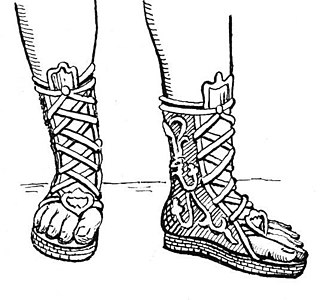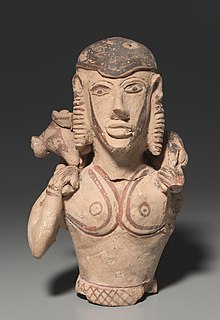 W
WClothing in ancient Greece primarily consisted of the chiton, peplos, himation, and chlamys. Ancient Greek civilians typically wore two pieces of clothing draped about the body: an undergarment and a cloak.
 W
WAn abolla was a cloak-like garment worn by ancient Greeks and Romans. Nonius Marcellus quotes a passage of Varro to show that it was a garment worn by soldiers, and thus opposed to the toga.
 W
WA buskin is a knee- or calf-length boot made of leather or cloth, enclosed by material, and laced, from above the toes to the top of the boot, and open across the toes. A high-heeled version was worn by Athenian tragic actors. It was also worn by hunters, and soldiers in Ancient Greek, Etruscan, and Roman societies, to protect the lower legs against thorns, dirt, etc.
 W
WByzantine dress changed considerably over the thousand years of the Empire, but was essentially conservative. The Byzantines liked colour and pattern, and made and exported very richly patterned cloth, especially Byzantine silk, woven and embroidered for the upper classes, and resist-dyed and printed for the lower. A different border or trimming round the edges was very common, and many single stripes down the body or around the upper arm are seen, often denoting class or rank. Taste for the middle and upper classes followed the latest fashions at the Imperial Court. As in the West during the Middle Ages, clothing was very expensive for the poor, who probably wore the same well-worn clothes nearly all the time; this meant in particular that any costume owned by most women needed to fit throughout the full length of a pregnancy.
 W
WA chiton is a form of tunic that fastens at the shoulder, worn by men and women of Ancient Greece and Rome. There are two forms of chiton. One is the Doric chiton and the later Ionic chiton. According to Herodotus, popular legend was that Athenian women began to wear the chiton as opposed to the peplos after several women stabbed a messenger to death with the bronze pins characteristic of that garment.
 W
WCoa vestis is an ancient type of fabric named after its point of origin, the Greek island Kos.
 W
WThe exomis was a Greek tunic used by the workers and the light infantry. The tunic largely replaced the older chitoniskos as the main tunic of the hoplites during the later 5th century BC. It was made of two rectangles of linen, which were stitched together from the sides to form a cylinder, leaving enough space at the top for the arms. An opening at the top was also left for the head. The cylinder was gathered up at the waist with a cloth belt using a reef knot, which made the cloth fall down over the belt, hiding it from view. To allow freedom of movement to the right arm, the seam at the right shoulder was taken apart, and the right hand was passed through the head opening.
 W
WFustanella is a traditional pleated skirt-like garment that is also referred to as a kilt worn by men of many nations in the Balkans. In modern times, the fustanella is part of Balkan folk dresses. In Greece, a short version of the fustanella is worn by ceremonial military units such as the Evzones, while in Albania it was worn by the Royal Guard in the interbellum era. Both Greece and Albania claim the fustanella as a national costume. Additionally Aromanians claim the fustanella as their ethnic costume.
 W
WGreek dress refers to the clothing of the Greek people and citizens of Greece from the antiquity to the modern times.
 W
WA himation was a type of clothing, a mantle or wrap worn by ancient Greek men and women from the Archaic through the Hellenistic periods. It was usually worn over a chiton and/or peplos, but was made of heavier drape and played the role of a cloak or shawl. When the himation was used alone, without a chiton, and served both as a chiton and as a cloak, it was called an achiton. The himation was markedly less voluminous than the Roman toga. It was usually a large rectangular piece of woollen cloth. Many vase paintings depict women wearing a himation as a veil covering their faces.
 W
WThe kausia was an ancient Macedonian flat hat.
 W
WThe kolpos is the blousing of a peplos, chiton or tunic in Ancient Greek clothing, whereby excess length of the material hangs folded over a zone.
 W
WA kynodesmē was a cord or string or sometimes a leather strip that was worn by some athletes in Ancient Greece and Etruria to prevent the exposure of the glans penis in public. It was tied tightly around the akroposthion, the part of the foreskin that extends beyond the glans.
 W
WA mariner's cap, variations of which are known as skipper cap, Greek fisherman's cap, fiddler cap or Breton cap, Lenin cap and Mao cap, is a soft, flat-topped cap with a small visor, usually made from black or navy blue wool felt, but also occasionally from corduroy or blue denim. It is distinguished from similar caps, such as the peaked cap and maciejówka, by its soft, unstructured crown. It is often associated with seamanship and maritime settings, especially fishing, yachting and recreational sailing. It has become popular amongst the public in general, rather than staying isolated as an occupational hat. One example of it being put in prominence in popular culture was when it was worn by John Lennon during the British Invasion of the mid-1960s.
 W
WMuseum of the History of the Greek Costume is a special interest museum in Athens, Greece. It was inaugurated by the former Minister of Culture, Melina Mercouri, in 1988 and is part of the Lyceum Club of Greek Women, a non profit society founded in 1911.
 W
WA peplos is a body-length garment established as typical attire for women in ancient Greece by circa 500 BC, during the late Archaic and Classical period. It was a long, rectangular cloth with the top edge folded down about halfway, so that what was the top of the rectangle was now draped below the waist, and the bottom of the rectangle was at the ankle. The peplos was draped and open on one side of the body, like the Doric chiton.The garment was then gathered about the waist and the folded top edge pinned over the shoulders. The folded-down top of the cloth provided the appearance of a second piece of clothing.
 W
WPerizoma is a type of loincloth that originated with the Minoan civilization in Crete. Surviving depictions show it being worn by male and female acrobats.
 W
WA petasos or petasus is a sun hat of Thessalian origin worn by ancient Greeks, Thracians and Etruscans, often in combination with the chlamys cape. It was usually made of wool felt, leather or straw, with a broad, floppy brim. It was worn primarily by farmers and travellers, and was considered characteristic of rural people. As a winged hat, it became the symbol of Hermes, the Greek mythological messenger god.
 W
WThe pileus was a brimless, felt cap worn in Ancient Greece, Etruria, Illyria, Pannonia and surrounding regions, later also introduced in Ancient Rome. In the 5th century BC, a bronze version began to appear in Ancient Greece and it became a popular infantry helmet. It occasionally had a horsehair crest. The Greek πιλίδιον and Latin pilleolus were smaller versions, similar to a skullcap. The plis worn today in Albania and Kosovo is thought to originate from a similar felt cap worn by the ancient Illyrians.
 W
WPteruges refers to strip-like defences for the upper parts of limbs attached to armor in the Greco-Roman world.
 W
WIn ancient Greek costume, a tainia was a headband, ribbon, or fillet.
 W
WA tsarouchi is a type of shoe, which is typically known nowadays as part of the traditional uniform worn by the Evzones of the Greek Presidential Guard.
 W
WA tunic is a garment for the body, usually simple in style, reaching from the shoulders to a length somewhere between the hips and the knees. The name derives from the Latin tunica, the basic garment worn by both men and women in Ancient Rome, which in turn was based on earlier Greek garments that covered wearers' waists.
 W
WSome authors have argued that use of costume in Athenian tragedy was standardized for the genre. This is said to have consisted of a full-length or short tunic, a cloak and soft leather boots, and may have been derived from the robes of Dionysian priests or invented by Aeschylus. Brockett, however, disputes this, arguing that the evidence we have is based on archaeological remains, some few references in the texts, and the writings of later authors. As far as the vase paintings are concerned, most of these are dated later than the 5th Century BCE and their relationship with theatrical practice is unclear. One of the earliest examples is a red-figure vase painting c. 500-490 BCE that shows a tragic chorus invoking a ghost, on a crater (bowl) in the Antikenmuseum in Basle.
 W
WA zoster was a form of girdle or belt worn by men and perhaps later by women in ancient Greece, from the Archaic period to the Hellenistic period.